|
|
|
|
|
|
|
Achi-Kochi Japan
Showing many places to visit and foods to eat in Japan
|
|
|
|
|
|
|
|
|
|
|
|
|
Japan
> Tokyo region
> Chichijima, Ogasawara Islands
|
|
|
|
|
|
|
Chichijima, Ogasawara Islands
Tokyo ( Achi-Kochi Japan )
|
|
|
|
|
|
|
|
|
|
|
|
|
( "Achi-Kochi" in Japanese means "Here and there" in English. )
Chichijima, Ogasawara Islands
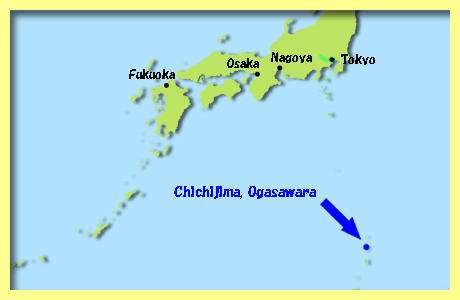
The Ogasawara Islands ( or the Bonin Islands ), one of UNESCO World Natural Heritage sites, have never been a part of the continent. While the population is a few thousands, there live many unique plants and animals who are endemic. In addition, mountains are covered with forests and beautiful beaches are quiet. Chichijima is the main island of the Ogasawara Islands, which belong to Tokyo Metropolis.
|
|
Passenger Liner

There is no airport in the Ogasawara Islands. So the only way to go to the islands is to get on board a passenger liner to Chichijima, the main island of the Ogasawara Islands. The vessel cruises from Tokyo Takeshiba Ship Terminal ( above ) to Chichijima in about 24 hours.
Though there is a large restaurant, a lounge and a shop in the vessel, a few bottles of wine, some foods and a few books in your bag would help your 24 hours on board.
|
|
Brown Booby
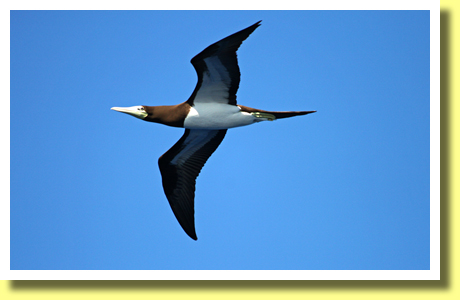
In the morning of the 2nd day on board, a brown booby ( above ) could be seen. Brown Boobies build nests in some of the Ogasawara Islands. So their flying over the ship shows that the islands are not so far. They fly around the islands to catch squids and flying fishes.
|
|
Chichijima

After 24 hours on board, the vessel arrives at Chichijima ( above ). The next liner ship for Tokyo arrives 6 days later, though another passenger liner ship leaves Chichijima for Hahajima, another island of the Ogasawara Islands, 4-5 times a week.
So visitors can not get out of the islands in 6 days, which could be something like an exile. However it is going to be an exile in a distant but subtropical island which has beautiful beaches and green mountains. 6 days could not be too long.
Ocean activities in Chichijima ( such as whale watching, dolphin swimming, scuba diving and so on ) could be arranged by travel agencies.
|
|
Shima-zushi
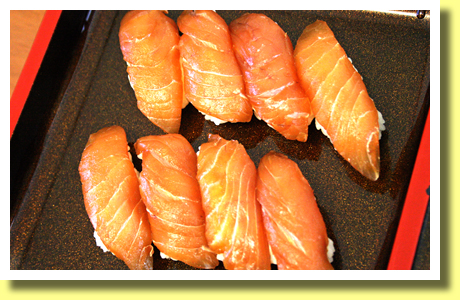
A liner ship from Tokyo is expected to arrive in Chichijima at 11:00 am. So it is lunchtime. A local specialty dish recommendable for lunch is Shima-zushi ( above ), a unique variation of Sushi.
Sushi topping of Shima-zushi is not raw but pickled slices of wahoo ( scombrid fish ), which are pickled in soy sauce and sweet sake for seasoning. Also in Shima-zushi, not Wasabi ( Japanese horseradish ) but Karashi ( Japanese mustard ) is used.
Pickled fish kept for a longer time in subtropical islands without a refrigerator. Also it was impossible to obtain Japanese horseradish in such islands. So people in the islands ate not ordinary but Shima-zushi. "Shima" in Japanese means "island(s)". Of course, there are many restaurants serving ordinary sushi in "Shima" now.
|
|
Kopepe Beach
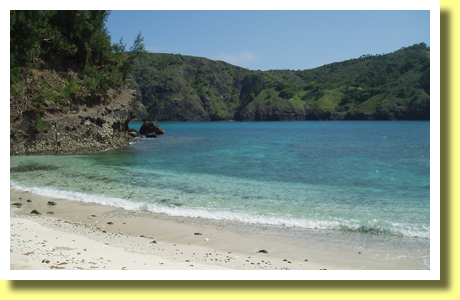
Kopepe Beach ( above ) is one of a dozen beaches on Chichijima and suitable for snorkeling. Beside the beach, there is no shop nor a resting house but a forest which is suitable to take a rest. In the sea, corals and fishes could be seen.
It is said that "Kopepe", name of the beach is derived from a native Hawaiian who came to and lived in Chichijima in A.D.1830 with some European and Amrican people who established an American Colony as a whaling base.
In A.D.1862, a ship, sent by Tokugawa Shogunate, arrived in Chichijima and proclaimed Japanese sovereignty over the Ogasawara Islands. The shogunate sent Japanese immigrants to the islands. In A.D.1876, the islands were internationally accepted as Japanese territory and some more Japanese immigrants arrived in A.D.1876.
|
|
Terrestrial Hermit Crab

Murasaki-oka-yadokari ( Blueberry Hermit Crab - above ) could be walking on the beach. They are one of Natural Monuments of Japan. 4 species of Terrestrial Hermit Crabs including Blueberry Hermit Crab live in the Ogasawara Islands.
|
|
Nakayama Pass
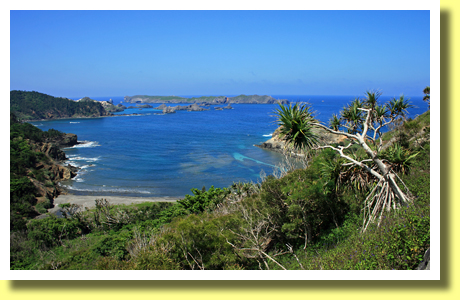
It is a fun to walk to John Beach through Nakayama Pass. Near the pass, there is an observation platform, from which tourists could enjoy a splendid view ( above ). However there is no shop nor vending machine along the walking path. So it is recommended to bring plenty of water ( more than 3 liters of water per person ) with you.
|
|
John Beach
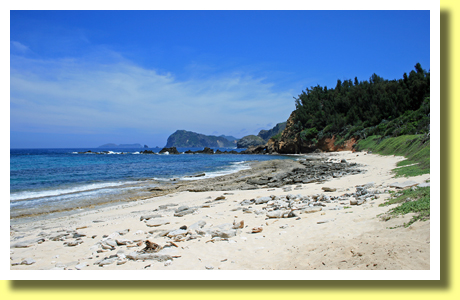
John Beach ( above ) is 2.5-3 hours walk from Kominato Beach. It is said that John Beach is one of the most beautiful in Chichijima. However visitors are expected to be careful about strong currents.
|
|
Ogasawara Tokage

On the way to and/or from John Beach, tourists could see a small lizard as above, which is a Ogasawara Tokage ( Ogasawara snake-eyed skink ), one of the endemic species of the Ogasawara Islands. It is said that waves brought their ancestors on driftwood to the islands from the southern Pacfic Ocean and they evolved endemically. Ogasawara Tokage is one of unique wild animals living in Japan.
|
|
Green Anole
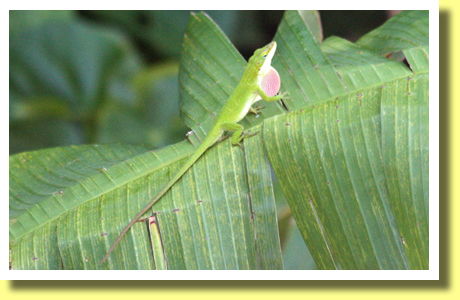
Green Anole ( American Chameleon - above ) would be seen Achi-Kochi ( here and there ) in Chichijima. They feed on small insects. They are not native to the Ogasawara Islands. It is said that they were brought from U.S.A. to the islands in the pet trade in the 1960s.
Now millions of green anoles live in the Ogasawara Islands and threaten the native insects. Some of endemic insects have been exterminated in some areas by green anoles. The authority concerned and people are trying to reduce the population of green anoles.
|
|
Sea Turtle

On the way back from John Beach to Nakayama Pass, visitors could walk along Buta Beach where the above photo was taken. It shows footprints of sea turtles who land at the beaches to spawn. Also at John Beach, their footprints could be seen.
|
|
Kominato Beach
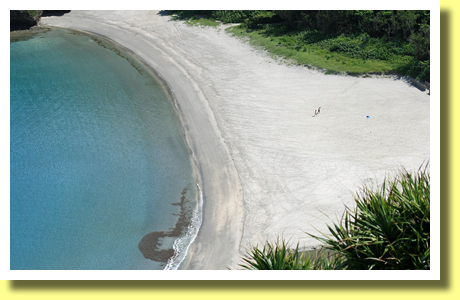
At Nakayama Pass, tourists could enjoy views again. The above shows Kominato Beach, which offers white sand and clear water. Kominato Beach may not be suitable for snorkeling but is one of the best beaches for swimming and sunbath on Chichijima.
|
|
Sunset

There are benches on Kominato Beach, which is suitable not only for swimming and sunbath, but also for viewing the sunset over the ocean with some wine.
|
|
Remains of WWII
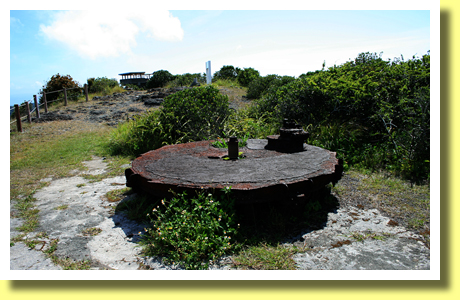
On the top of Mount Chuo, 319m above sea level, there is an observatory platform, which provides tourists with a 360 degree view. Near the platform, there is a rusty wheel ( above ), which is the remains of rader equipment used during WWII.
Thousands of Japanese soldiers were stationed in the Ogasawara Islands during WWII and there are the remains relating to the soldiers and the war here and there in the islands. In A.D.1945 after the war, the islands were occupied by U.S.Army. It was in A.D.1968 when the islands were returned to Japan.
|
|
Green Sea Turtle Sashimi
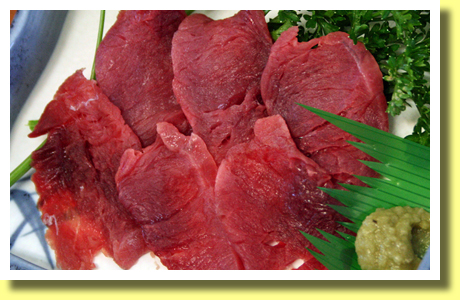
Traditionally people of the Ogasawara Islands caught green sea turtles as foods. Though they have been and are protected since A.D.1910 in the islands, one fisherman is allowed to catch green sea turtles under a certain restrictions. So some restaurants in the islands serve green sea turtle dishes such as Sashimi ( above ). Green sea turtle is one of unique seafoods in the islands. However the population of green sea turtles is increasing gradually in the islands.
Green sea turtle soup had been so popular in England in the 18th century that turtles in some areas were almost exterminated and they ate mock turtle soup in Alice's Wonderland as well as in England. The Ogasawara Islands are to remain a kind of wonderland with green sea turtles surviving.
|
Copyright (c) 2021 Achi-Kochi Zanmai Co., Ltd.
|